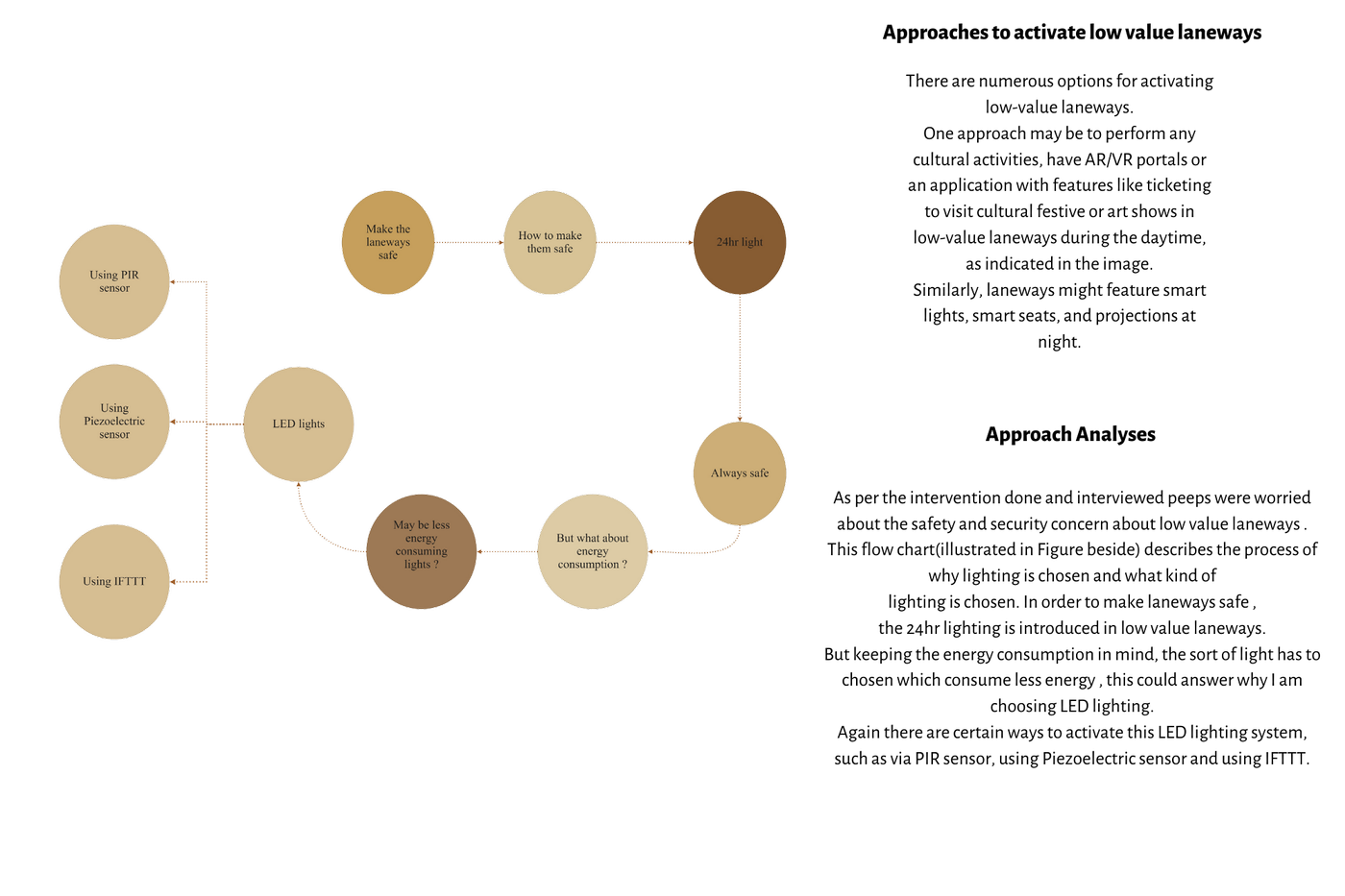Laneways
23 December, 2021
Laneways, often known as alleyways, are narrow roadways that add to the diversity of the city’s overall network of public places, enhancing the city’s attractiveness. The changes began in the nineteenth century, when laneways were classified into three categories based on their characteristics: high, medium, and low value. In certain aspects, medium and low-value laneways require activation to keep people engaged and return them to a vibrant place. The project will examine high, medium, and low lanes during the 2020 pandemic and see how low-value lanes can be activated post Covid both day and night.

also the creative industry. Research has been initiated to enable low-value lanes by lighting it up at night using smart lighting technology and proposing a design system that allows creative artists and the public to post-pandemic throughlaneways(during the Day).
It's disappointing that the City of Melbourne's 192 low-value laneways have been underutilized. Many pedestrians have expressed dissatisfaction with the quality of low-value laneways, claiming that they are dirty and dangerous. These concerns are seen on a regular basis, and they only get worse during festival and summer seasons when there are more people around. Giving these laneways a new purpose is the only way to bring them back to life. When they’re used frequently, they’re reintroduced as
an important component of the city.Our aim is to design a system that connects the laneways to the public and serves as a public amenity rather than merely a pathway.



Bureau of Statistics, with this number decreasing as the epidemic progressed. Following a fast surge of Covid-19 instances, metropolitan Melbourne and several regions of regional Victoria were subjected to ‘Stage 4 restrictions’ and ‘lockdowns’ from July to September 2020.
The need to impose containment measures across Australia, particularly in Victoria, through ‘lockdowns’ that included social distancing orders, movement restrictions, and a nightly curfew, resulted in galleries and museums closing their doors, festivals and concerts being canceled, and
musicians and performers being barred from venues and studios. The arts and creative sectors rely on a greater proportion of technical and administrative professionals, many of whom lost their jobs and income as a result of the pandemic(Jacinthe Flore, Natalie Ann Hendry & Averyl Gaylor, 2021).



To test the working of this process, the first IFTTT app and Wiz app is installed on the mobile phone. Then using IFTTT, an applet that switches on the Wiz Smart light on button press is connected. The next step is to integrate the IFTTT app with Wiz App for seamless communication using an activation code. Once this is set up The IFTTT applet can turn ON/OFF the light.




The prototype screen sequence begins at the top left continues through the on boarding screen, and concludes with the user information screen.
The prototype’s on boarding screens answer the questions of why, what, and how by explaining the impact of the 2020 pandemic on the creative industry, features, and how the experience could be, respectively. Service screen gives users a chance to select whether to book the laneway, visit the laneway or just demonstrate lighting operation in the laneways.
After the user selects an option on the service screen. They will be directed to fill in information such as their name, email address, and so on. If the user chooses to hire the laneways, they will be able to select the type of exhibition to set up in the chosen laneway.They will be led to the ‘Choose your laneway screen’ after selecting the type of exhibition . If
a user wishes to know about the history of a laneway, there will be an option to do so.Then a preview of the art that has been placed in the laneway will be provided to give users an idea of how their art will appear in the laneway during the day and at night.
They will be requested to select suitable days after selecting the
laneways in order to arrange and book the laneway. Following the booking, the same information will be emailed to the email address provided. If the user chooses to visit the laneway rather than book, they
will have the opportunity to see the work of their favorite artists,
as well as save and create their own itinerary . After they’ve chosen their favorite work, artist, and laneway to visit, they’ll be asked to select the dates they want to visit and the dates that are available, and they’ll be mailed the same information.
Users will still have access to the laneways if they do not want to
book or visit them to see the art. They have the choice of choosing
lighting operation and turning on them lights as they enter the laneway.

industries a chance to re-enter the market, art will be displayed in the
laneway in the form of a gallery, musical performers will perform in the
laneway, and a reading area will be setup.
Low value laneways can be accessed during time with lights on. This way laneways are used and activated t any time of day and time.
To test the prototype, please click here

1
